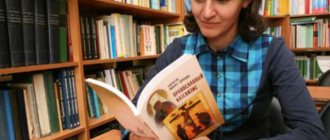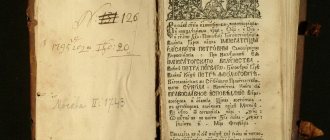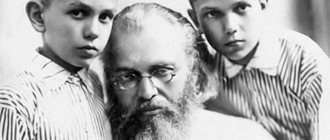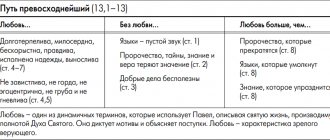“Go therefore and teach all nations, baptizing them in the name of the Father and the Son and the Holy Spirit. Teaching them to observe everything that I have commanded you” (Matthew 28:19-20).
In this global commission given from above to the first disciples and apostles of Christ
The call to educate sounds twice. That is why the need to reveal the meaning and content of the spiritual path to salvation has been facing the Church from the very beginning of its creation and is being realized at different levels of accessibility. One of the forms of church preaching is the catechism.
Icon of the Apostolic Sermons
Meaning of the word
The word “catechism” is of Greek origin and means a collection of doctrinal provisions that help to understand the fundamentals of religious doctrine. Simply put, this is a short primer on the essence of Christianity.
.
The first examples of such literature appeared in response to the request of the young, growing Church. The most famous monuments of early Christian thought are addressed to those wishing to be baptized
and
new ones
, the oldest among them is “Didache” (1st century).
These works contain the quintessence of Christian doctrine, but are not directly called catechisms. And in their free form they are very different from later religious literature of a didactic nature.
Interesting fact
The first books with the inscription “Catechism” on the cover were published only at the beginning of the 16th century.
Their authors were Catholics
and Protestants.
The classic form of a short guide to the basics of the Christian faith, “question and answer,” which has become established over time, arose in the West during the era of the Reformation. The most famous of them are Martin Luther's Small and Large Catechisms.
The first Orthodox catechisms published in Rus'
In the tradition of primary religious education in Rus', the following were used:
- simple primers;
- collections of prayers
with their interpretation; - missals
.
All these manuscripts necessarily contained the Creed.
.
Detailed lists of Christian virtues
could be found in various kinds of teachings, conversations contained in special books called “catechumens”. In turn, “catechumens” in Rus' were those who were preparing to be baptized.
The most popular reading in Russia were the lives
of saints,
whose exploits portrayed high examples of Christian life to grateful readers or listeners.
Trying to imitate these numerous worthy examples, man actually learned to comprehend the moral Law of God
.
Useful materials
At the disposal of the educated Russian clergy
and monasticism, there were also a large number of manuscripts with texts by respected Greek authors.
Thanks to a careful study of the works of the holy fathers
, such luminaries of spirituality appeared on our land as St. Sergius of Radonezh, who in his youth had the opportunity to explore the precious treasures of church thought.
The need for the appearance of catechisms itself was due to the opposition of our Church to numerous attempts to penetrate into the territory of Russia together with missionaries
and simply travelers of Catholic and Protestant views. Orthodox theology urgently needed active and serious defense, the creation of clear definitions of faith in the form of short textbooks.
The content of the first Russian catechisms was directed against the heterodox errors pouring in from the West.
- The work of Lavrenty Zizaniy Tustanovsky, which appeared in Western Rus' in 1620, set as its goal a victorious polemic with Catholicism, but itself fell under the influence of the latter. The book of Zizania contained an entire treatise dedicated to purgatory.
- In 1720, a primer called “The First Teaching of a Youth” was published, compiled by Archbishop of Novgorod Feofan Prokopovich, which, along with questions and answers, contained the commandments of the Old Testament Decalogue
. Armed with the methods of Protestant science in the fight against Catholic scholasticism, this primer went to a new extreme.
Interesting fact
A very interesting fact should be noted.
Emperor Peter I himself declared the need to create a catechism understandable to the common people. In his opinion, expressed in a message to the Synod
, this simple book should contain “instructions that there is a direct path to salvation... and especially faith, hope and love ( for they know very little about the first and last... and they haven’t even heard of the middle one), since they put all their hope in church singing, fasting and bowing, and so on...”
Confession of Metropolitan Peter Mohyla
“The Orthodox Confession of Faith of the Catholic and Apostolic Church of the East” is the result of the collective creativity of Metropolitan Peter himself and his associates.
The first edition took place in 1642 in Latin, a version in Greek appeared a year later, and a translation into Church Slavonic was published in 1685.
Even fairly cleaned up of the influence of scholasticism for translation into colloquial Greek, Peter Mogila’s document remains the most “Latin-wise” Orthodox text of the 17th century. Having been translated into Russian in 1837, this work has been used since the end of the 19th century. the adequacy of the transmission of Orthodox doctrine has been disputed.
The purpose of the catechism is indicated in the preface to it:
“This book is published not only so that priests in their parishes read and explain it to their parishioners every day, especially on Sundays and holidays; but also that worldly people who know how to read teach the Christian doctrine in the same way, especially that parents teach their children from it, and the owners of the people under their control, and also that in schools all teachers force their students to learn by heart from this book.”
The “Orthodox Confession” has a symbolic three-part form:
- the first part examines the Creed;
- the second part is devoted to prayer and the beatitudes;
- the third part completes the study of the fundamentals with an appeal to good deeds.
Work of Metropolitan Platon (Levshin)
A good attempt to correct the situation with spiritual illiteracy was the work of the future metropolitan
Plato (Levshin). It was called "The Catechism, or the original instruction in the Christian law, publicly interpreted in 1757-1758."
Metropolitan Platon (Levshin)
This collection of accessible conversations described the process of preparing a believer to enter the Church over a period of 9 months, like the gradual growth of a baby in the womb. The catechism was wittily tied to the annual liturgical circle and was completely devoid of any harmful scholasticism.
Subsequently, Levshin created several more collections, both to help the clergy and for the personal use of the heir to the throne, young Paul. It is in the works of this church figure that we find the first serious appeal to the patristic tradition. His catechisms were in demand by Russian Orthodox society until the end of the 19th century.
Long Catechism of Metropolitan Philaret (Drozdov)
The official order of the church authorities for the appearance of a unified textbook on the fundamentals of faith, which should fully satisfy the needs of education, arose as a result of the reform at the beginning of the 19th century. Its implementation was entrusted to Philaret, a student of Metropolitan Platon.
Saint Philaret of Moscow
“Long Christian Catechism of the Orthodox Catholic Eastern Church” by Philaret (Drozdov) was published in 1823. The ardent desire to continue the work of his teacher in a patristic manner found opposition in the context of pro-Catholic trends.
Metropolitan Philaret of Moscow had to adjust his work.
The revised version included the Catholic doctrine of predestination, replaced quotes in Russian with Church Slavonic, and added a chapter on Holy Tradition
. Despite the objections of Metropolitan Philaret himself to many edits, it was published in 1839.
The reaction of educated society to this work was far from unambiguous. Some reproached him for statements that were dangerous for Orthodoxy, others emphasized the complexity of the text and provisions of the spiritual textbook for ordinary lay people.
Nevertheless, Drozdov’s creations were taken for a long time as the basis of spiritual religious education in Russia.
Interesting fact
To this day, the work of Metropolitan Philaret, as amended by members of the Synod, remains the only generally accepted catechism in the Russian Orthodox Church.
1.2. WHAT IS FAITH?
a) First of all, faith is understood as a state of psychological confidence in the truth of certain provisions that cannot be logically proven and experimentally verified.
In relation to the Christian religion, faith means confidence in the existence of God and the spiritual world, as well as in the fulfillment of Divine promises. Ap. Paul defines faith as “the substance of things hoped for and the evidence of things not seen” (Heb. 11:1).
According to the interpretation of the Long Catechism, this means
“confidence in the invisible, as if in the visible, in what is desired and expected, as if in the present” [ ].
Such faith is the basis of religious life as such,
“For he who comes to God must believe that He exists and is a rewarder of those who diligently seek Him” (Heb. 11:6).
b) Faith also refers to the very object of certainty, that is, some teaching in the truth of which a person is convinced. St. Petersburg uses the word “faith” in this meaning. Paul, when he speaks of people who “have rejected the former faith” (1 Tim. 5:12), of “ignorants of the faith” (2 Tim. 3:8). In this sense, we can talk about Christian, Muslim, Jewish and other faiths.
c) The God of the Bible is not an abstract entity, but a living Personality, a freely rational Being with whom a person can enter into direct personal communication and be united by the closest inner union. By faith we gain access to Divine grace, by faith Christ dwells in our hearts (Eph. 3:17). Christian faith is initially faith in a Person, and not in a doctrine, therefore the faith of Christians, in principle, cannot be limited only to formal recognition of the truth of Christian teaching. According to the outstanding Russian theologian of the first half of the 20th century. V.N. Lossky, “faith is not a psychological state,” but an ontological connection (that is, a connection in being - O.D.) between man and God, an internally objective connection” [].
From the subjective side, such faith is revealed, first of all, as trust - trust in what God reveals to us in His word, trust in God's Providence.
“Abraham believed God, and it was counted to him as righteousness” (Rom. 4:3).
The act of faith performed by Abraham did not consist in the fact that the patriarch recognized the existence of God - he had no doubt about this before - but in the fact that he trusted God, completely surrendered himself to the will of God.
Trust in God, His commands and promises gives rise to a person’s desire to remain faithful to God. At low degrees of spiritual development, the desire to be faithful to God may be due to the fear of punishment or the desire to receive a reward. However, neither fear nor selfish calculation can convey the fidelity of a positive moral foundation and are therefore incompatible with Christian perfection. Such a basis can only be love as “the totality of perfection” (Col. 3:14).
“God is love” (1 John 4:8; 16), and faith in God - Love, as it grows, is dissolved by love, but love encourages you to remain faithful to the one you love:
“If you love Me, keep My commandments” (John 14:15);
“Whoever loves Me will keep My word” (John 14:23).
In this sense, ap. Paul speaks of “faith working through love” (Gal. 5:6).
d) Thus, Christian faith cannot be reduced either to simple confidence in the truth of Christian teaching, or to a state of mind, or even to a person’s personal relationship with God. We can say that faith is, first of all, a certain way of life. On the one hand, its content is the desire for communion with God, for union with God. On the other hand, this way of life certainly includes a firm determination to do the will of God, to bring one’s life into conformity with the Divine plan for man.
Modern editions
Currently, the Russian Orthodox Church is working to create a new document that meets the needs of society in content and style.
Attempts are being made to present the fundamentals of the doctrine in a new way. The work of Rev. is widely known. Oleg Davydenkov “Catechism. Introduction to Dogmatic Theology". It is used today as a recommended manual in theological schools.
The draft of the official catechism of the Russian Orthodox Church was prepared by the Synodal Biblical and Theological Commission, headed by Metropolitan Hilarion (Alfeev). It was published in 2022 for church-wide discussion.
Today this work continues taking into account the adopted amendments and proposals.
Benefits for children
Individual Orthodox catechisms for children's audiences are appearing in our time. In 1995, “Catechism in Stories” by S. Uspensky was published. And in 2014, Deacon Georgy Maximov’s book “Catechism for Children” was published, consisting of 37 separate parts.
"Faith of the Saints" St. Nikolai Serbsky
It is not for nothing that Saint Nicholas (Velimirović) is called the “Serbian Chrysostom”. His works are included in the treasury of Orthodox thought of the 20th century.
Work of St. Nicholas, which can be classified in form and content as literature for teaching the basics of the Christian faith, is called “The Faith of the Saints.” This is a classic dialogue in the form of questions and answers, with the help of which the teaching of the Orthodox Church is presented.
2.2. WHAT IS NEEDED FOR RESCUE
The purpose of fallen man's life is to achieve salvation. The Long Catechism teaches that "to please God and to save the soul" are necessary [ ]:
a) “knowledge of the true God”
But what does it mean to “know God”? After all, God is not an object of knowledge in the generally accepted sense of the word! Since God is a Person, knowledge of Him is possible only through a personal relationship, that is, in the experience of communication with God. Therefore, true knowledge of God is not a way of thinking, but, first of all, a way of life, life in direct unity with God.
b) “right faith in Him”
Proclamation of the Decembrist S.I. Muravyov-Apostol
The concept of “catechism” was used not only to designate doctrinal literature. Any profound manual that was schematically similar to a religious document was called a catechism. An example of this is the “Orthodox Catechism” by Muravyov-Apostol.
This proclamation of revolutionary content was read out on the morning of December 31, 1825 in St. Petersburg in front of the line of rebel soldiers of the Chernigov regiment. The document advocated the creation of a democratic republic and was anti-serfdom in its content, calling for the overthrow of the tsar and an immediate uprising against those in power.
The calls for riots against the existing government here directly referred to biblical texts. In addition, the “Orthodox Catechism” of the Decembrists provides a Christian justification for the need for military service; patriotic motives of love for the Fatherland are based on eternal truths.
1.3. SUBJECT OF THIS COURSE
When we define the catechism as instruction in the faith, we mean by it a review of the fundamental truths of Christian doctrine. The truths of faith can be divided into three groups:
a) doctrinal truths, containing knowledge about God and His relationship to the world and to man;
b) moral truths, establishing the range of a person’s moral duties in relation to God, to himself and to his fellow men;
c) truths that can be called mystical, related to the practice of communication with God.
This course of the Catechism is limited to consideration only of the basic doctrinal truths contained in the Nicene-Constantinopolitan Creed.










